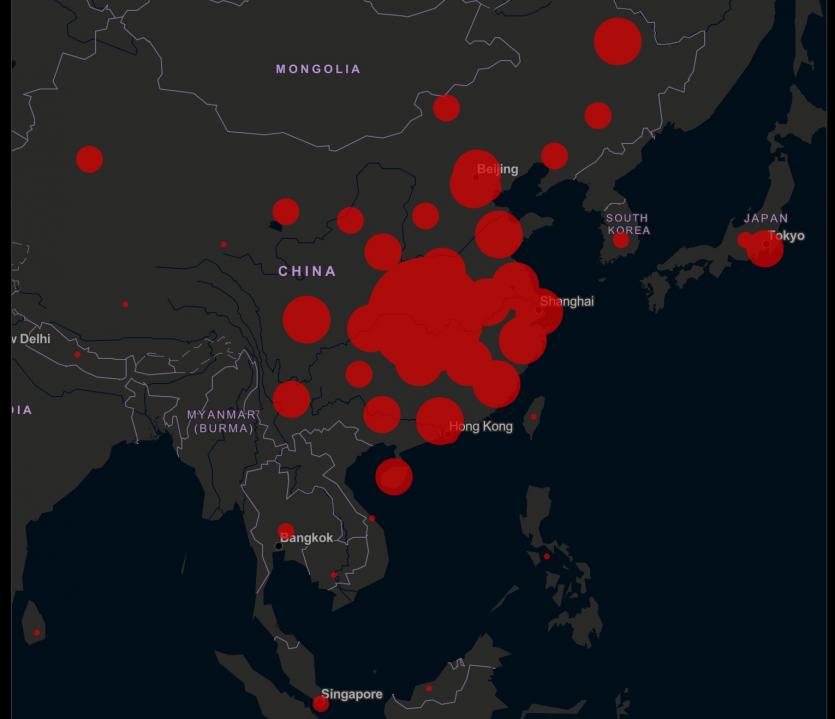Source: Johns Hopkins University CSSE
 FEBRUARY 13th 2020
FEBRUARY 13th 2020
By Patryk Krych | From London | The World Daily
Coronavirus Infection Count Skyrockets – How Dangerous is the Virus?
As the days pass on, more people are killed and even more infected by the new coronavirus that’s been spreading around the world as of late, summarily originating from the East. But what threat does the virus pose to the world, and what’s being done to stop it? Here’s what we know so far.
The term ‘coronavirus’ is used to categories a series of viruses that infect mammals, and target their respiratory systems primarily. This recent virus is much the same, sharing many of the same symptoms – shortness of breath, coughing, and a fever. As such, it’s relatively easy to spread, as a simple sneeze, cough, handshake, or even discarded tissue could let the virus travel from body to body, as with many other respiratory illnesses. All according to a report from the NHS in United Kingdom.
As I write this, the death toll of the virus has risen past 1,300 according to Chinese Health Officials in the Hubei province, where the virus had hit the country hard. Their recent report of 242 extra casualties to add atop the piling number has pushed the toll over that boundary. This, along with the coronavirus having recently been giving the official name of ‘COVID-19’ has made it clear to the entire world that it’s no small issue. At least 60,000 people have been infected already, 14,840 of those infections having had occurred overnight, as reported by the Hubei officials.
With such great numbers, many are curious as to the virus’ survivability, and how it’s spread so far. The total number of cases in the UK as I write this has risen to nine, according to Chief Medical Officer Chris Whitty, after recent panic over a quarantined women who’d flown into the UK from China not long ago – now being treated for the virus. However, the danger has by no means been stopped there, according to London doctors who warn of the dangers of the London Underground. They warn that it may be a potential hotbed for the infection, along with most other forms of transport in the city where many people convene and come across one another during the day.

Source: Johns Hopkins University CSSE
Dr Robin Thompson of Oxford University said that “In general, if an initial case is in a densely populated area, then the risk of sustained person-to-person transmission following is higher. This is exacerbated by the fact that London is a transport hub, and the underground could provide a network to spread the virus quickly.”
Any surface may leave traces of the infection behind, and according to statistics, at least an estimated 5 million people use the London Underground every day, making the place a potential breeding ground for the virus. However, according to Dr Michael Head from the University of Southampton, there had been at least 1,750 tests taken for the virus so far in the UK, and of all the tests, over 99% of them had proven negative against the viral infection. Furthermore, the National Institute for Health Research have advised that commuters in London need but “go about their business as usual” at the present moment.
“Thus,” He added, “Risks to Londoners and UK residents remain low, though people should continue to keep an eye on guidance for the general public.”
Dr Nathalie MacDermott also contributed some advice to the public regarding the virus, stating that “Provided the individual followed the government’s advice (to self-isolate) there should be little concern of transmission to the general public in London.”
The UK is not the only country that the virus has spread to. In fact, most scientists have expressed concerns over the fact that some of the countries where the virus has spread to are also the countries who’d be amongst the least capable of containing it. Outside of China, 24 countries have reported cases of the virus so far. And more are possible, seeing as some researchers expect incidents of unreported cases in countries with much weaker, less developed healthcare systems. Southeast Asia and Africa are in particular danger, as the virus could easily burn through their large populace and overwhelm them quickly, experts say. Despite this, there have been no reported cases in Africa just yet. However, there are particular fears over how the virus might manifest in Nigeria specifically, due it its strong ties to China.
The same officials who’d given the virus its official name; those being the researchers at the International Committee on Taxonomy of Viruses, have noted that the virus has many critical similarities to the SARS virus. Scientists have been making research models of the virus, designed to speculate as to its the future spread using flight data. One model of the data disclosed the open possibility of at least 30 countries seeing a rise in infection rates due to their more frequent travel lines connecting with the virus’ epicentre of Wuhan, in China. According to the study, Thailand is the country at most risk to infection – and has already reported several cases.
No country is suffering the virus’ infection as badly as China itself, however, where the majority of the cases can be found. As of February 11th, 2020, it’s been found that at least 4,200 people have made full recoveries from the virus and that the vast majority of these recoveries had been made in China – this according to a tracking study made by Johns Hopkins University, who have been following the updates from Chinese officials. Thus it can be attained that the virus has a higher recovery rate than it has a death rate – and the recovery rate only keeps increasing by comparison. This by no means makes the infection harmless, but could be considered a positive development.
As the infection rates have drastically risen in China recently, its government is shifting just as rapidly, with nobody yet to blame for the incident. It’s been reported by the official Xinhua news agency that the head of the Communist Party in the province of Hubei: Jiang Chaoliang, had been deposed and replaced by former Shanghai Mayor: Ying Yong. Chaoliang was not the only one to be replaced, as the chief of the health commission of Hubei from the Communist Party, Zhang Jin, and its director, Liu Yingzi, had also been replaced by new officials. Similar events had transpired during the country’s 2003 SARS outbreak, under the grave circumstances.
Katrina Yu of Al Jazeera reported from Beijing, stating that "It was expected that somebody's head was on the chopping block. There's been a lot of criticism about the information not being so forthcoming (from the Hubei officials)."
The NHS have published advice on how to act if one suspects themselves or a loved one to have been infected with the virus, and primarily urge people to call 111. They also advise everyone to cover their mouths and nose with a tissue or sleeve (not their hands) when you cough or sneeze, to try avoid close contact with people who are unwell, and to was their hands as frequently and as often as possible.
By Patryk Krych | The World Daily, LONDON






